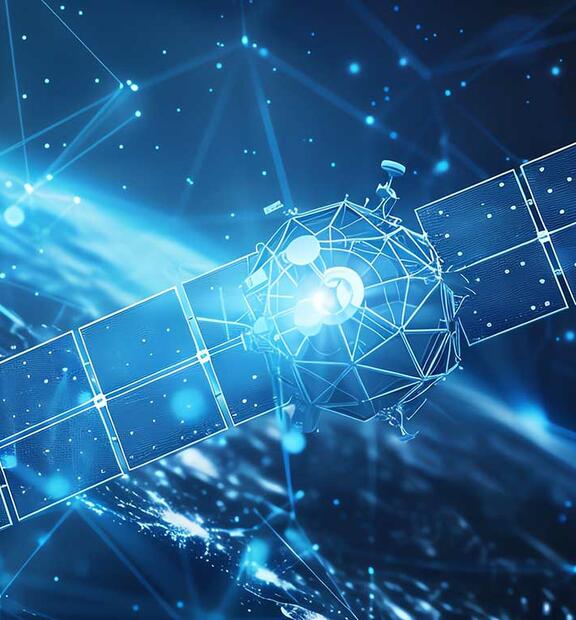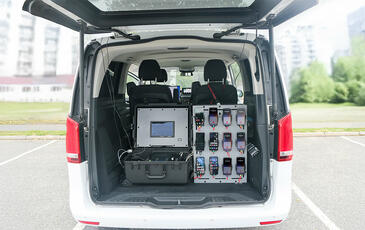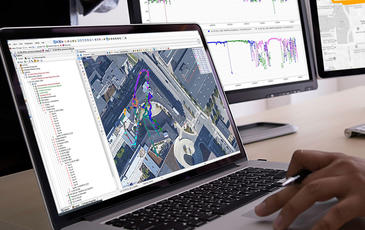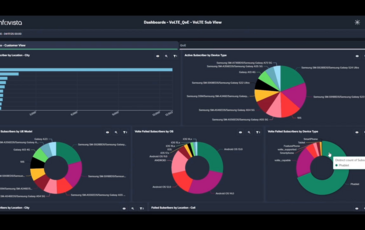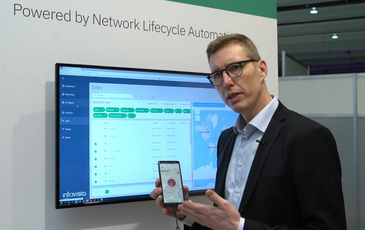Mobile communications have always relied on terrestrial infrastructure. But even the most extensive terrestrial networks have coverage gaps. Remote rural areas, ocean routes, air corridors, disaster zones…. often remain disconnected because deploying fiber or towers there is simply not economically or logistically viable.
Non-terrestrial networks (NTNs) are emerging as a solution. By integrating satellites, high-altitude platforms (HAPS), and unmanned aerial vehicles (UAVs) with existing mobile networks, operators can extend coverage far beyond the reach of traditional cell sites. Today, with the standardization through 3GPP Releases and commercial trials by leading operators, NTNs have become a core feature of the 5G Advanced roadmap.
Non-terrestrial networks (NTN): what they are and how they work?
Non-Terrestrial Networks (NTNs) are wireless communication networks that rely on infrastructure not located on the ground, most commonly, satellites. They also encompass high-altitude platforms (HAPS), such as balloons and drones, as well as uncrewed aerial systems (UAS) operating at various altitudes.
These elements complement terrestrial infrastructure by delivering coverage where cell towers can’t reach: from oceans and remote forests to disaster zones and underserved rural regions.
By design, NTNs are built to extend the reach of terrestrial networks, not replace them. That’s why architecture often brings hybrid networks, blending terrestrial and non-terrestrial components to deliver seamless global coverage. This combination is especially crucial for 5G Advanced, where expectations around mobility, latency, and ubiquity are far higher than in previous generations.
Today’s NTN systems are evolving to support direct-to-device (D2D) connectivity, and they’re also being integrated into IoT ecosystems, mission-critical services, and backhaul connectivity for hard-to-reach areas.

What’s the difference between terrestrial networks (TN) and non-terrestrial networks (NTN)?
The key difference between terrestrial and non-terrestrial networks (NTNs) lies in infrastructure and coverage.
Terrestrial networks use fixed towers and base stations, delivering predictable, low-latency coverage with established cell-to-cell handovers.
NTNs, on the other hand, use moving satellites in LEO (Low Earth Orbit), MEO (Medium Earth Orbit), or GEO (Geostationary Earth Orbit) orbits, creating dynamic coverage areas and variable latency (20–500 ms). They require handovers between ground and satellite links and must address unique challenges like atmospheric interference and time-dependent coverage mapping.
These distinctions demand specialized planning, testing, and optimization methods to ensure service quality.
Comparative table of non-terrestrial networks vs terrestrial networks
| Aspect | Terrestrial Network | Non-Terrestrial Network |
|---|---|---|
| Infrastructure | Fixed towers, static coverage areas | Moving satellites, dynamic coverage |
| Latency | Low | Variable |
| Coverage Mapping | Static | Time-dependent |
| Propagation | Multipath, building penetration | Atmospheric effects, rain fade |
| Handover | Cell-to-cell | Ground ↔ Satellite ↔ Ground |
Non-terrestrial networks architecture
NTNs operate across three main orbital layers, Low Earth Orbit (LEO) satellites, Medium Earth Orbit (MEO) satellites, and Geostationary Earth Orbit (GEO) satellites, each with different capabilities, performance characteristics, and target applications:
Comparative table of non-terrestrial networks orbital layers
Orbit Type | Altitude | Latency | Advantages | Challenges | Well-suited for |
|---|---|---|---|---|---|
LEO (Low Earth Orbit) | ~180–2,000 km | Low (~20–50 ms) | Fast latency, lower power use, frequent refresh of coverage | Requires dense constellations, rapid satellite handovers | Broadband, direct-to-device, and IoT services |
MEO (Medium Earth Orbit) | ~2,000–35,786km | Medium (~50–150 ms) | Broader coverage per satellite | Higher latency, fewer commercial deployments today | Maritime, aviation, and regional coverage applications |
GEO (Geostationary Orbit) | ~35,786 km | High (~500–700 ms) | Fixed position, large footprint | Significant latency, not ideal for real-time apps or interactive services | Broadcast, TV, backhaul, and emergency coverage |
Satellite-based NTNs are supported by ground-based gateways that connect the satellite constellations to the terrestrial internet. Signals travel through feeder links, or RF connections, between satellites and ground stations, and often across laser inter-satellite links (ISLs) that transmit data directly between satellites to optimize routing and reduce latency.
The network may also involve store-and-forward mechanisms, where satellites temporarily hold data until a ground station is in range. While practical in some use cases, it introduces transmission delays and may limit applications where real-time communication is critical.
In addition to satellites, High-altitude platform systems (HAPS), such as stratospheric balloons or UAVs, are being tested to complement NTN deployments. They operate at around 20 km altitude, in the stratosphere, and can provide localized, low-latency (<20 ms) coverage for events, emergencies, or niche rural areas.
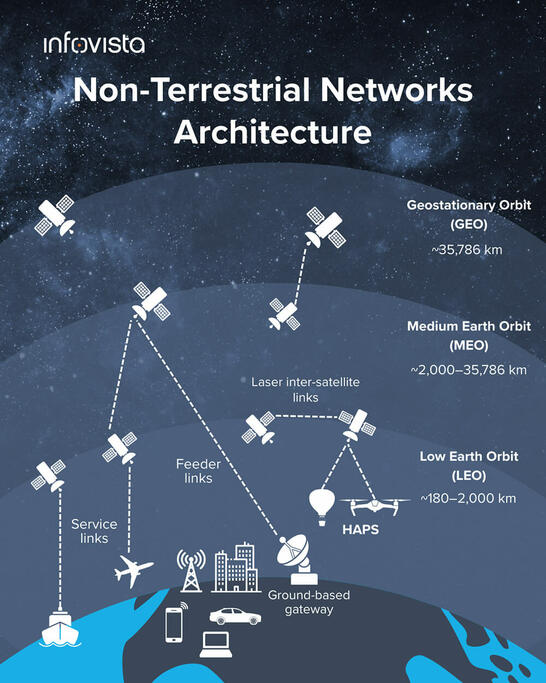
Why is the interest in non-terrestrial networks rising in the telecom industry?
Non-Terrestrial Networks (NTNs) are quickly being adopted and implemented thanks to rising operator demand, maturing satellite infrastructure, and global standardization.
Momentum is already visible. What was once considered a niche connectivity solution is now becoming an essential part of the 5G Advanced roadmap.
According to multiple industry reports, including ABI Research, the NTN market is forecast to grow at a CAGR of between 33 - 38%, with estimations that the NTN-Mobile segment will reach a market value of nearly $18 billion by 2030, with up to 200M connections. This growth is fueled by factors such as:
- Affordable small satellites (CubeSats)
- Rapid expansion of LEO constellations
- Standardized support for NTNs in the latest 3GPP Releases
- Major investments and collaborations from governments, telecom providers, and aerospace companies.
What’s the NTN market picture looking like?
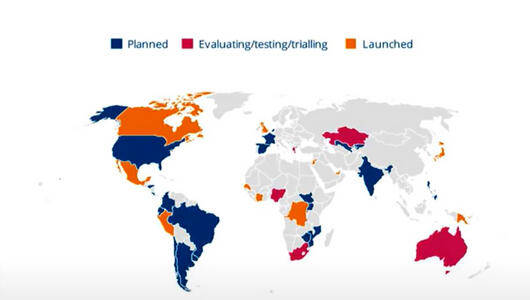
According to GSMA intelligence, at the beginning of 2025, more than 90 mobile operators worldwide already formed satellite partnerships, with nearly 20 commercial services launched.
Operators in North America, Asia Pacific, and parts of Africa and Latin America are leading early deployments, aiming to extend service to rural, maritime, and underserved areas.
This surge in activity reflects growing commercial potential. Trials of direct-to-device (D2D) satellite connectivity are showing that customers are willing to pay a premium for extended coverage. In some markets, early 2025 data from GSMA intelligence indicates a potential 10–30% ARPU uplift when satellite connectivity is included in premium bundles.
Beyond consumer broadband, IoT satellite connectivity has emerged as a high-value opportunity. Billions of connected devices in energy, agriculture, transport, and logistics sectors operate outside terrestrial coverage areas. NTN services can connect these devices at low data rates and low cost, enabling business models that were not viable before.
Image source: GSA snapshot 3GPP-based NTN
Learn how to successfully test NTNs, backed by 30 years of expertise
The NTN market progress is rapidly expanding, presenting great opportunities, but also higher network complexity that must be addressed from the beginning: the planning and testing phase.
Access now our guide to successfully testing non-terrestrial networks and be backed by Infovista’s 30+ years of experience in the testing landscape.
Click to read online eBook
Non-terrestrial networks 3GPP standards
Before 2022, satellite communications operated largely outside the mainstream mobile ecosystem, using proprietary protocols and custom devices. That changed when 3GPP launched its 17 Release, which standardized NR-NTN (New Radio for Non-Terrestrial Networks) within the 5G framework. The next 3GPP releases have covered different aspects of 5G NTN
- Release 17: defines the waveforms, protocols, and architecture needed for NTNs to integrate seamlessly with existing terrestrial 5G networks. This includes support for satellite backhaul, transparent “bent-pipe” payloads, and regenerative payloads with onboard processing.
- Release 18, part of the 5G Advanced phase, adds enhanced mobility support, improved multi-connectivity between terrestrial and non-terrestrial layers, and early optimizations for IoT devices.
- Release 19: 3GPP Rel-19 is now in development. It will focus more heavily on IoT satellite connectivity (NTN-IoT), improving power efficiency, reducing terminal costs, and expanding NTN support to narrowband devices.
This standardization is a turning point: operators can now deploy NTNs as extensions of their existing 5G networks, using similar core network functions, security frameworks, and spectrum.
Non-terrestrial networks are unlocking a broad range of applications across both commercial and public sectors. From extending mobile broadband to enabling new categories of IoT services, the potential of NTNs lies in their ability to deliver coverage, resilience, and mobility where traditional networks can’t reach.
Here are the most relevant groups of non-terrestrial use cases:
Key NTN use cases
- Direct-to-Device connectivity (D2D)
- Rural & remote broadband access
- IoT satellite connectivity & industrial applications
- Public safety, disaster recovery & national resilience
- Maritime, aviation & mobility use cases

One of the most talked-about use cases is D2D connectivity. This allows standard smartphones to connect to satellites without special hardware.
The most widely adopted early application is satellite-based SOS and emergency text messaging. This feature, already deployed in several markets, allows users to send messages to emergency services when outside terrestrial mobile coverage, a critical step toward universal safety and resilience.
Beyond emergency use, D2D is particularly attractive for rural populations and frequent travelers who want continuous connectivity without gaps.
Looking ahead, 3GPP Releases 18 and 19 and ongoing operator trials (e.g., Vodafone/AST SpaceMobile, AT&T, Lynk Global) indicate that D2D will gradually expand beyond emergency SMS into voice, data, and IoT services and is set to become a key part of the 5G Advanced ecosystem.*
*Source: 3GPP NTN Overview & The future of Satellite and NTN Summit, MCW25, GSMA

One of the most talked-about use cases is D2D connectivity. This allows standard smartphones to connect to satellites without special hardware.
The most widely adopted early application is satellite-based SOS and emergency text messaging. This feature, already deployed in several markets, allows users to send messages to emergency services when outside terrestrial mobile coverage, a critical step toward universal safety and resilience.
Beyond emergency use, D2D is particularly attractive for rural populations and frequent travelers who want continuous connectivity without gaps.
Looking ahead, 3GPP Releases 18 and 19 and ongoing operator trials (e.g., Vodafone/AST SpaceMobile, AT&T, Lynk Global) indicate that D2D will gradually expand beyond emergency SMS into voice, data, and IoT services and is set to become a key part of the 5G Advanced ecosystem.*
*Source: 3GPP NTN Overview & The future of Satellite and NTN Summit, MCW25, GSMA

NTNs are a natural fit to close the digital divide. By using LEO satellite constellations for fixed wireless access (FWA) and backhauling isolated cell sites, operators can serve rural homes, clinics, and schools, without waiting for fiber or microwave infrastructure.
For mobile network operators, this means monetizing hard-to-reach segments while improving national coverage KPIs and regulatory obligations.

NTNs are a natural fit to close the digital divide. By using LEO satellite constellations for fixed wireless access (FWA) and backhauling isolated cell sites, operators can serve rural homes, clinics, and schools, without waiting for fiber or microwave infrastructure.
For mobile network operators, this means monetizing hard-to-reach segments while improving national coverage KPIs and regulatory obligations.
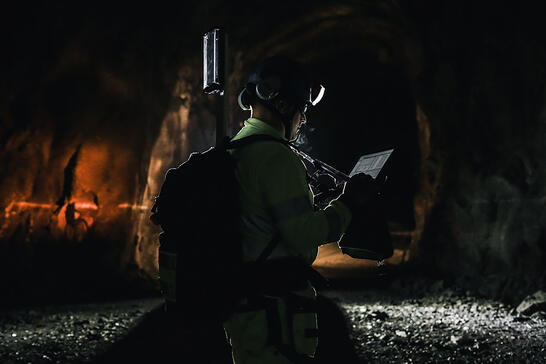
The surge in IoT adoption across verticals, from agriculture to energy, has created a need for ubiquitous, low-power connectivity in areas where terrestrial networks fall short.
NTNs support massive machine-type communications (mMTC) via narrowband IoT (NB-IoT) over satellite. These services enable:
- Smart farming: soil sensors, irrigation control, and livestock tracking
- Energy & utilities: powerline and pipeline monitoring
- Supply chains: global asset tracking and cold chain monitoring
- Mining & exploration: remote site automation and environmental sensing

The surge in IoT adoption across verticals, from agriculture to energy, has created a need for ubiquitous, low-power connectivity in areas where terrestrial networks fall short.
NTNs support massive machine-type communications (mMTC) via narrowband IoT (NB-IoT) over satellite. These services enable:
- Smart farming: soil sensors, irrigation control, and livestock tracking
- Energy & utilities: powerline and pipeline monitoring
- Supply chains: global asset tracking and cold chain monitoring
- Mining & exploration: remote site automation and environmental sensing

NTNs also play a crucial role in emergency response scenarios. When terrestrial infrastructure is damaged by natural disasters or conflict, GEO and LEO satellite links provide immediate backup to re-establish voice, data, and mission-critical services.
Governments and first responders increasingly rely on NTNs for:
- Real-time coordination during wildfires, floods, and earthquakes
- Emergency broadcasts and alerts
- Connectivity for temporary shelters and field hospitals

NTNs also play a crucial role in emergency response scenarios. When terrestrial infrastructure is damaged by natural disasters or conflict, GEO and LEO satellite links provide immediate backup to re-establish voice, data, and mission-critical services.
Governments and first responders increasingly rely on NTNs for:
- Real-time coordination during wildfires, floods, and earthquakes
- Emergency broadcasts and alerts
- Connectivity for temporary shelters and field hospitals

Ships, planes, and autonomous vehicles operate in environments where ground-based connectivity is not feasible. NTNs offer seamless broadband coverage for:
- Passenger infotainment systems
- Fleet management and telemetry
- Flight and maritime route tracking
- Vehicle-to-everything (V2X) communication in remote corridors
As NTN support is integrated into 5G Advanced and beyond, mobility use cases will become increasingly sophisticated.

Ships, planes, and autonomous vehicles operate in environments where ground-based connectivity is not feasible. NTNs offer seamless broadband coverage for:
- Passenger infotainment systems
- Fleet management and telemetry
- Flight and maritime route tracking
- Vehicle-to-everything (V2X) communication in remote corridors
As NTN support is integrated into 5G Advanced and beyond, mobility use cases will become increasingly sophisticated.
Opportunities and challenges of NTNs
As NTN technologies evolve and gain momentum, understanding their benefits and limitations is essential for assessing their long-term role in 5G and beyond. NTNs offer undeniable advantages in terms of reach, resilience, revenue and service innovation, but these come with equally complex challenges in integration, performance, and standardization that require a shift in how operators, vendors, and regulators think about design, deployment, and monetization.
What are the advantages of NTNs?
- Ubiquitous coverage: NTNs extend network connectivity to remote, rural, maritime, and airborne environments where terrestrial infrastructure is unavailable or too costly to deploy. This includes oceanic routes, deserts, mountainous regions, and low-population density areas.
- Network resilience: In the event of natural disasters or outages, NTNs provide a resilient layer of backup connectivity. GEO and LEO satellites can maintain critical communications when ground networks are compromised.
- Efficient multicast and broadcast services: NTNs are well-suited for broadcast-type use cases, such as delivering updates or media content to a wide area simultaneously, ideal for firmware updates, public alerts, and emergency communication.
- Support for Direct-to-Device (D2D) connectivity: Thanks to advancements in 5G NR NTN (3GPP Release 17+), satellites can now support direct connections to unmodified smartphones and IoT devices, a game-changer for the mobility and IoT sectors.
- Flexible backhaul for 5G networks: NTNs can serve as a backhaul alternative in areas where fiber or microwave links are not feasible. This enables MNOs to expand their coverage footprint without significant terrestrial investment.
- Low-latency potential in LEO networks: With altitudes of 180–2000 km, LEO satellites provide latency levels low enough to support real-time applications, including voice and some video use cases.
What are the challenges of NTNs?
- Doppler shift and propagation delay: LEO satellites move at high velocities (~7.5 km/s), causing rapid changes in frequency and timing (Doppler effect). This directly affects the stability of voice calls, data sessions, and even IoT telemetry. Compensation mechanisms must be implemented at both the device (terminal) and network level to maintain link quality. At higher altitudes, such as GEO, latency becomes the dominant factor, with round-trip delays that can exceed 500 ms, impacting real-time applications.
- Handover complexity in motion: Unlike terrestrial networks where cell site boundaries are relatively fixed, NTN coverage areas are constantly moving. Devices may need to hand over between satellites every few minutes. This increases the complexity of session management, especially for mobility-heavy use cases like aviation or maritime, where seamless service continuity is critical for both safety and customer experience.
- Antenna design and tracking requirements: To maintain stable links with fast-moving satellites, NTNs often require electronically steered, phased-array antennas capable of beam steering. These antennas are more complex, expensive, and power-hungry than those used in terrestrial networks. For D2D (direct-to-device) NTN services, integrating such capabilities into standard smartphones without compromising battery life is a major engineering challenge.
- Spectrum coordination and cross-border regulation: NTNs must share spectrum with terrestrial mobile services and other satellite systems, often in S-band or Ka-band frequencies. In regions like Europe, where spectrum allocations vary by country, cross-border interference can become a real issue. Mitigation strategies include moving into standardized spectrum (SS) bands and executing phased rollouts in close coordination with regulators.
- Strategic partnerships highlighted by GSA on NTNs such as T-Mobile with Starlink, Deutsche Telekom with Skylo, and Vodafone with AST SpaceMobile, show how operators are navigating these spectrum and interoperability challenges through collaboration.
- Integration with 5G core and RAN: NTNs must interoperate with existing 5G infrastructure and standards (via 3GPP Releases 17–19). This includes harmonizing the air interface, control signaling, and user-plane protocols, which requires ongoing collaboration between network vendors, standards bodies, and operators, and extensive NTN testing to avoid service disruption.
- Cost and business model uncertainty: While investment in NTNs is growing, pricing models are still in flux. Operators must decide whether to bundle satellite coverage, offer it as a premium add-on, or subsidize it through partnerships. Pricing decisions will depend on factors like device availability, coverage density, and the perceived value of continuous connectivity, especially in D2D scenarios.
- Device certification and ecosystem readiness: IMT-based satellite-to-cell technology promises that any unmodified smartphone can connect to compatible NTNs. In practice, early deployments often face limitations, not due to hardware, but because each handset model must undergo network testing, verification, and regulatory approval before service activation. In some regions, this is done device-by-device, slowing adoption and making ecosystem readiness a key dependency for market growth.
The future of non-terrestrial networks

How 5G NTNs integrate into 5G Advanced
As 5G transitions into 5G Advanced, NTNs will become a standardized layer within hybrid networks. This means:
- Seamless service continuity between terrestrial and satellite layers
- Dynamic traffic routing: low-latency services stay on terrestrial, while delay-tolerant services can be offloaded to satellites
- Vertical-specific NTN integration: private 5G + NTN for sectors like mining, maritime, and defense

Non-terrestrial networks and 6G
Looking beyond 5G Advanced:
- Inter-satellite links (ISLs) will allow satellites to route traffic without ground stations, improving latency and coverage continuity.
- Optical satellite communications will increase throughput and spectral efficiency.
- AI-driven network orchestration will optimize beam management and handovers.
- 3GPP Release 20 will likely introduce early 6G NTN capabilities, further integrating space-based communications into the global network.

NTNs and hybrid networks
Hybrid networks will require careful coordination across the spectrum, core functions, and beam management, but the result will be truly global mobile coverage.
Start testing NTNs with confidence
Testing non-terrestrial networks requires new methodologies to handle satellite dynamics, atmospheric conditions, and hybrid network integration.
For an in-depth analysis of NTN testing best practices, see our eBook: Testing 5G Non-Terrestrial Networks: Methods, Challenges & Best Practices.
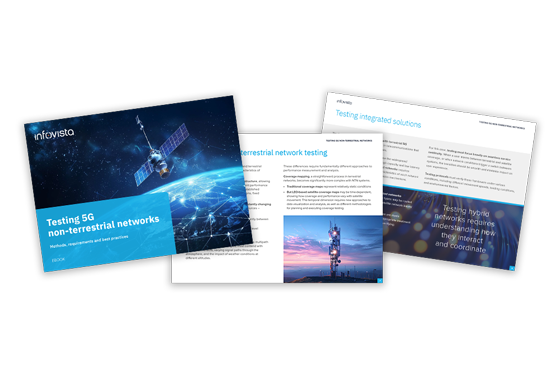
Explore the TEMS™ Suite
Discover TEMS, Infovista’s suite of tools to empower your network testing efficiency and autonomy for advanced networks.
TEMS Investigation
Perform drive tests to verify, optimize and troubleshoot all your mobile network technologies
TEMS Sense
Proactively monitor your wireless network services end-to-end with active testing
TEMS Discovery
Turn your network test data into analytics and actionable insights for optimization
FAQs
A non-terrestrial network (NTN) is a network that uses satellites, HAPS, or UAVs that orbit across LEO, MEO and GEO orbits to complement terrestrial 5G networks, extending coverage beyond the reach of cell towers.
Terrestrial networks use fixed ground-based towers for stable, low-latency coverage, while non-terrestrial networks (NTNs) use moving satellites, resulting in dynamic coverage areas, variable latency, and unique challenges like atmospheric effects and time-dependent mapping.
They will be integrated into hybrid networks with seamless terrestrial–satellite service continuity, supported by 3GPP Releases 18 and 19.
NTNs connect to the 5G core via 3GPP standards, enabling seamless handovers and shared infrastructure so devices switch between satellite and terrestrial coverage without service disruption.
Testing 5G NR-NTN in field trials requires adapting traditional network testing to the dynamic nature of satellites. In Low Earth Orbit (LEO), satellites move at ~7.8 km/s, so tests must account for Doppler shifts, variable elevation angles, and frequent handovers.
Methods include: Drive testing, Stationary testing, 24h monitoring and Specialized equipment with GPS correlation, Doppler compensation, and multi-stream logging.
North America is currently the most advanced region in terms of non-terrestrial network (NTN) technology adoption. It dominates global NTN technological deployment, market share, and infrastructure investment.
NTNs are standardized by 3GPP in Releases 17–19, defining air interface, signaling, and integration with 5G core networks. They use protocols such as 5G NR for direct-to-device services, NB-IoT for IoT connectivity, and standardized spectrum bands (e.g., S, L, and Ka) to ensure interoperability between satellite and terrestrial systems.
NTNs can match terrestrial networks in security and reliability when designed to 3GPP standards, with encryption, authentication, and redundancy built in. Reliability benefits from wide-area coverage and resilience during disasters, though challenges like latency, handover complexity, and weather-related signal loss in some bands mean performance optimization is key.
NTNs extend connectivity beyond the reach of traditional terrestrial infrastructure by using satellites in LEO, MEO, or GEO to provide broadband and IoT services in rural, remote, and hard-to-reach regions. They enable cost-effective broadband access (for homes, businesses, schools, and healthcare facilities), maritime, aviation, and remote industrial connectivity for continuous operations, and support for public services like telemedicine, e-learning, and emergency communications.
Cross-border interference can be minimized through close coordination between regulators and operators, alignment on standardized spectrum bands, and phased rollouts. According to GSA, strategic partnerships, such as Vodafone–AST SpaceMobile or T-Mobile–Starlink, are an example of how collaboration helps ensure seamless NTN service across regions.
The IMT-based satellite-to-cell model is designed to connect standard, unmodified smartphones directly to satellites. However, according to GSA, in early NTN deployments, availability is limited due to the need for device-by-device testing, network verification, and regulatory approval in each region before activation.
Glossary of terms
- 3GPP (3rd Generation Partnership Project): A global standards body that develops protocols for mobile telecommunications, including NTN specifications in Releases 17–19.
- 5G Advanced: An evolution of 5G defined in 3GPP Release 18 and beyond, adding capabilities like NTN integration, improved spectrum use, and advanced IoT support.
- 5G NTN (Non-Terrestrial Network): The extension of 5G connectivity through satellite and aerial platforms, enabling global coverage and integration with terrestrial networks.
- D2D (Direct-to-Device): A connectivity model where satellites communicate directly with standard, unmodified smartphones or IoT devices.
- Doppler Effect / Doppler Shift: Frequency change caused by the movement of LEO satellites relative to a receiver, requiring compensation in NTN design.
- GEO (Geostationary Orbit): A satellite orbit 35,786 km above Earth, where satellites remain fixed relative to the ground, offering wide coverage but higher latency.
- Hybrid Networks: Networks combining terrestrial and non-terrestrial infrastructure to deliver seamless coverage and capacity.
- Ka Band: A frequency range (26.5–40 GHz) often used in satellite communications for high-throughput data links.
- LEO (Low Earth Orbit): A satellite orbit between 180–2,000 km above Earth, used in NTNs for low-latency communications and real-time applications.
- MEO (Medium Earth Orbit): A satellite orbit between 2,000–35,786 km above Earth, balancing coverage area and latency.
- NB-IoT (Narrowband IoT): A low-power wide-area network (LPWAN) technology used in NTNs for IoT devices requiring small amounts of data over long distances.
- NTN-IoT: A type of NTN optimized for IoT use cases, offering global coverage for low-data-rate applications.
- NTN-NR: A type of NTN using 5G New Radio (NR) to provide higher-speed, low-latency connectivity, including direct-to-device services.
- Satellite Backhaul: Using satellite links to connect remote terrestrial cell sites to the core network, extending service to underserved areas..
- Spectrum Coordination: The regulatory process of managing frequency allocations to prevent interference between terrestrial and non-terrestrial systems.
